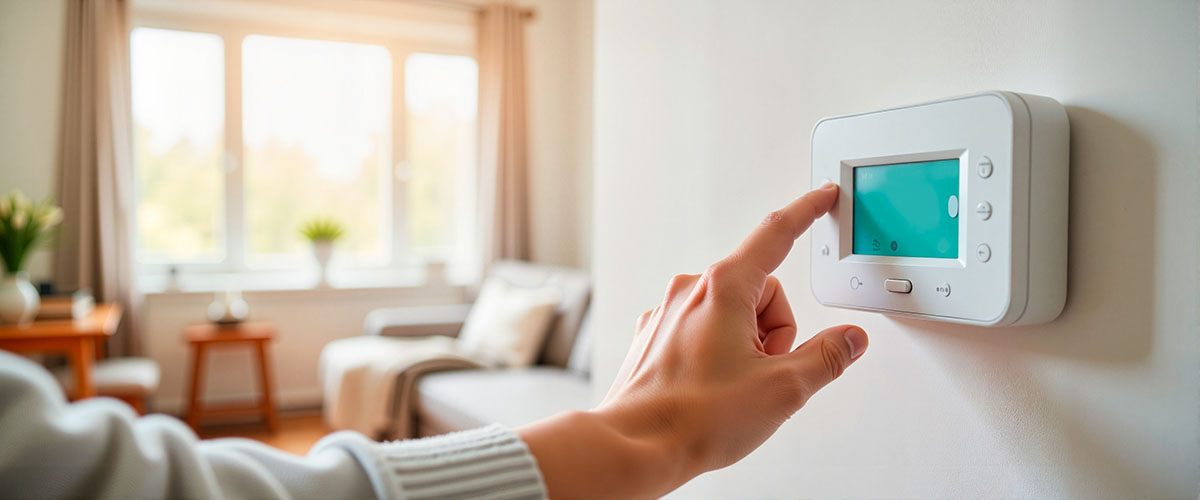So the screen’s frozen, the air’s not kicking on, and you’ve tapped that Honeywell faceplate so many times you’re worried you’ll smudge the gloss. I’ve been there—standing in front of a silent thermostat with the house already feeling sticky and warm, wondering if it’s the unit or just a brain-fogged control. The good news is that most Honeywell hiccups are fixable with a simple Honeywell thermostat reset. It’s not complicated or intimidating – just a few straightforward steps you can do with your own hands in a couple of minutes. I’ll guide you through it, and we’ll get your comfort back on track.
Understanding the Problem
A thermostat is the traffic cop of your HVAC system. When it glitches—after a power blip, dying batteries, a Wi‑Fi update gone sideways, or a jumbled schedule—it can send mixed signals. That’s when you start to notice odd symptoms: screen lagging, “Heat On” or “Cool On” blinking continuously, the blower running but no heat, or no response to button presses. I once watched a Honeywell sit there with a faint backlight glow and a stubborn 74°F, while the air handler hummed like a fridge at midnight. It wasn’t the equipment. It was the control logic tripping over itself.
Resetting clears that confusion. Think of it as turning a stuck page back to its starting point. There are two flavors: a soft reset (power cycling the stat to refresh its memory) and a factory reset (wiping schedules and preferences back to their default settings). We’ll start gently and only go deeper if necessary. And if your model is battery-powered versus hardwired, I’ll note the difference as we go.
Quick Fixes to Try First
Here are four easy steps I use for a Honeywell thermostat reset.
Step 1: Confirm power and settings. If your screen is dim or sluggish, replace it with fresh AA/AAA batteries (for battery-powered models). If yours is hardwired, ensure the furnace/air handler breaker is turned on. Set the system to ‘Off’, the Fan to ‘Auto’, and note your current schedule or temperatures so you can re-enter them later. Give it one minute to settle.
Step 2: Do a Honeywell thermostat reset. On many Honeywells, gently pull the thermostat straight off the wall plate; the display will go dark. Wait 60 seconds. You may hear the quiet click of a relay dropping inside the equipment—that’s normal. Re-seat the stat by pressing it evenly back into place until it snaps into position. If your model has a Menu, you can also look for a
Reset or Restore Defaults option and choose “Schedule” or “Preferences” instead of “Factory” to preserve Wi-Fi and system setup.
Step 3: Change to: Try the battery flip trick or cycle the breaker. If you don’t have a Reset in the menu and it’s still acting stubborn, remove the batteries, wait 30 seconds, then reinsert them backward for 10 seconds (yes, backward). Remove, then reinstall correctly. That clears the residual charge. If your unit is hardwired, switch the HVAC breaker off for one minute, then back on. You may see a “Wait” message on the screen for a few minutes during a safety time-out. This is normal and indicates that the system is resetting and recalibrating.
Step 4: If the problem persists, reset the thermostat. On most newer Honeywell models, press the Menu button, scroll to Reset, and select Factory. On older models without a menu, the battery flip often accomplishes the same. Afterward, set the date/time, reconnect to Wi-Fi if applicable, and enter your system type (heat pump vs. conventional), followed by your desired schedule. Listen for the soft click when calling for heat or cool—that’s your confirmation that the stat is communicating with the equipment.
Prevention and Maintenance
A few small habits can keep thermostat gremlins at bay. Replace batteries once a year—pick a convenient date, such as the first cool snap of fall. Fresh batteries prevent the faint-screen-and-random-reboot routine that shows up at the worst times. Keep the thermostat face clean: a dry microfiber cloth works; avoid cleaners that can seep into the seams. Every couple of months, remove the stat from the wall and gently blow out the dust; you’ll be surprised how much fine lint collects behind the plate, especially with pets or during pollen season, when dust can turn everything yellow.
Check the breaker panel after storms. Around here, we experience brief power flickers that can confuse electronics. A quick look for a half-tripped breaker and a power cycle saves a head scratch later. If you have a Wi-Fi model, update the app and firmware when prompted; the newer software tends to resolve connectivity issues. Also, ensure your thermostat isn’t located in a drafty hallway or directly in the sun—direct afternoon light can make it think the house is warmer than it actually is. Finally, keep return filters clean; a clogged filter can cause short cycling, which may appear to be a thermostat issue but often starts with airflow problems.
When Will You Need Professional Help
There’s a line between finicky control and an electrical problem. If your screen remains blank after replacing the batteries and performing a reset, the thermostat may not be receiving 24V from the system—possibly due to a blown low-voltage fuse or a tripped float switch caused by a clogged condensate drain. I’ve pulled more than one panel and found a tiny 3-amp blade fuse popped from a lightning surge. If the thermostat constantly loses time/date, reboots, or won’t hold settings, the control itself may be failing.
Call a professional if you notice burning smells, repeated short cycling (the system starts and stops every few minutes), or if the outdoor unit isn’t running while the indoor blower is—especially with heat pumps. Ants inside contactors (yes, really), water in the secondary drain pan, or a transformer humming louder than a refrigerator are clues that it’s not just the stat. Also, if you’re uncomfortable pulling the thermostat off its base or identifying the R, C, Y, W, and G wires, that’s perfectly normal—wiring checks take a multimeter and a careful hand. We make quick work of it and can protect the system with surge protection and proper float switches, which are crucial in a storm-prone area like Milledgeville, Georgia.
Common Questions
Will resetting the Honeywell thermostat erase my schedule?
A soft reset won’t. A factory reset will, so take a quick photo of your schedule before you start.
How long should “Wait” stay on the screen?
Usually 3–5 minutes. It’s a built-in compressor protection delay. If it never clears, the system may have a safety lockout.
Is the battery flip trick safe while resetting the Honeywell thermostat?
Yes, for Honeywell battery models—keep it to about 10 seconds and reinstall correctly.
Does resetting a Honeywell thermostat harm the HVAC system?
No. It simply clears the control’s memory. If problems remain, the issue is likely elsewhere, and a technician can pinpoint it fast.



